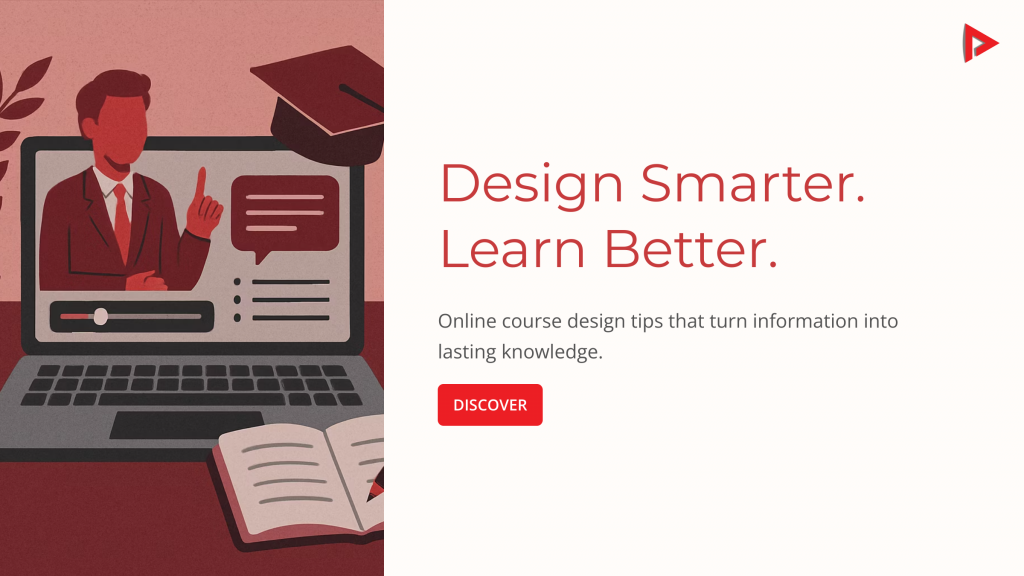
Online course design goes far beyond being a simple exercise in content delivery. Instead, it’s a craft rooted in how people absorb, retain, and apply knowledge. As more organisations shift to digital pedagogy, the true challenge isn’t creating access to training—it’s ensuring that learning sticks.
Without the right structure and engagement strategies, much of the information modern learners are bombarded with is forgotten.
Digital learning doesn’t have to feel transactional. With thoughtful design, it becomes transformative. At its core, a well-crafted course fosters clarity, relevance, and engagement—turning passive participants into active learners with long-term recall. That’s where strategic design meets measurable impact.
Join us as we explore the most effective techniques for designing courses that maximise knowledge retention.
Design with Purpose: Structure Fuels Retention
Retention starts with structure. When a course is logically organised and easy to navigate, learners spend less time figuring out how to learn and more time engaging with what matters. A strong structural foundation reduces cognitive overload and supports sustained attention—critical for knowledge retention.
Start by defining clear, outcome-focused learning objectives. These should go beyond what learners will know to what they’ll be able to do in real workplace contexts. Each module should be purpose-built to support those outcomes, creating a sense of progression and accomplishment.
Use a modular design approach to break content into manageable sections. This “chunking” strategy aligns with how the brain processes information, making it easier for learners to absorb and recall new concepts. Each section should have a consistent layout, with predictable patterns for video, text, interaction, and assessment.
Engage Emotion and Curiosity Through Storytelling
Facts inform, but stories transform. When learners are emotionally invested, they’re far more likely to remember what they’ve learned—and apply it.
Effective online course design weaves narrative elements throughout the learning experience. Start by identifying real-world challenges your audience faces, then frame your content around those scenarios. Instead of presenting abstract theory, introduce characters, conflicts, and choices that mirror learners’ day-to-day decisions. This makes content relatable—and retention more likely.
Use branching scenarios to place learners in control of the outcome. These interactive stories invite exploration and reflection, creating space for curiosity to thrive. When learners see the impact of their decisions unfold, they not only engage emotionally—they build stronger neural connections that reinforce memory.
Case studies, simulations, and persona-driven dialogues also work well to humanise content and add narrative depth. And where possible, connect each story back to the learner’s role, industry, or goals to enhance relevance and motivation for true learner-centred design.
Activate the Learner: Interaction Drives Memory
Passive learning is forgettable. To embed knowledge and build long-term retention, learners need to do—not just consume. Interaction transforms content from something learners observe into something they actively engage with, reinforcing memory through practice and feedback.
The most effective online courses incorporate interactive elements throughout the learner journey. This might include drag-and-drop exercises, knowledge checks, simulations, or scenario-based branching—all designed to prompt decision-making and critical thinking. These moments of active participation help shift information from short-term recall to long-term understanding.
Spaced repetition is another powerful technique. Reinforcing key concepts over time—rather than presenting them once—helps strengthen memory pathways. Short quizzes, recap prompts, or reflection checkpoints strategically placed across modules can deliver this without overwhelming the learner.
Partnering for Success
Creating courses that truly maximise knowledge retention takes more than great content—it takes strategic design, deep audience insight, and a commitment to measurable outcomes. For organisations navigating complex training needs, the path forward is clearer with the right partner.
Anderson Studios sees course design as a collaborative process grounded in creativity, cognitive science, and real-world impact. Every solution is built in partnership with learning leaders—designed to reflect your goals, your industry, and your learners.
If you’re ready to rethink your digital learning strategy and build solutions that deliver long-term impact, get in touch with the team at Anderson Studios.

